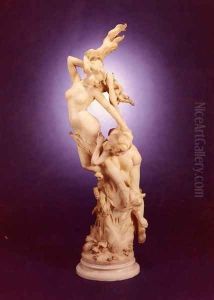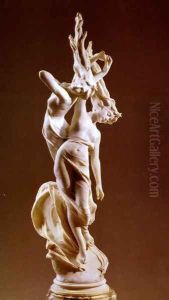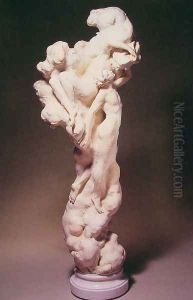Vittorio Caradossi Paintings
Vittorio Caradossi was an Italian sculptor born in 1861 in Florence, Italy. His life spanned a period of significant cultural and artistic development in Italy, marking him as a notable figure in the realm of sculptural art of the late 19th and early 20th centuries. Caradossi's work is emblematic of the transition from the romanticism that characterized much of 19th-century art to the burgeoning modernist trends that would come to define the early decades of the 20th century. His artistic education and career were deeply rooted in the rich cultural heritage of Florence, a city renowned for its unparalleled contributions to art and the Renaissance.
Caradossi trained at the prestigious Academy of Fine Arts in Florence, where he honed his skills under the tutelage of some of the most respected artists and sculptors of his time. This period of intense study and artistic exploration laid the foundation for his future work, imbuing his sculptures with a blend of classical beauty, emotional depth, and a nuanced understanding of human form and expression. Throughout his career, Caradossi exhibited a profound dedication to the craft of sculpture, exploring various materials including marble, bronze, and plaster, and engaging with a range of themes from mythological subjects to more contemporary figures and scenes.
Notably, Caradossi's sculptures were marked by their exquisite detail, dynamic forms, and the expressive intensity of the figures depicted. His works often reflected the influence of the Renaissance masters, yet Caradossi infused his sculptures with a modern sensibility that spoke to the complexities and nuances of the human experience. His ability to capture the subtleties of emotion and the intricacies of the human body earned him considerable acclaim during his lifetime.
Caradossi's contributions to the art world were not limited to his own creative output. He was also deeply involved in the artistic community in Florence, participating in exhibitions and engaging with contemporary debates about the direction of Italian art. His works were exhibited both in Italy and internationally, contributing to his reputation as a sculptor of significant talent and vision.
Vittorio Caradossi passed away in 1918, leaving behind a legacy of artistic achievement that continues to be celebrated today. His sculptures remain a testament to his skill, passion, and the enduring beauty of the human form. Through his work, Caradossi not only contributed to the rich tapestry of Italian art but also to the broader narrative of European artistic evolution at the turn of the century.


